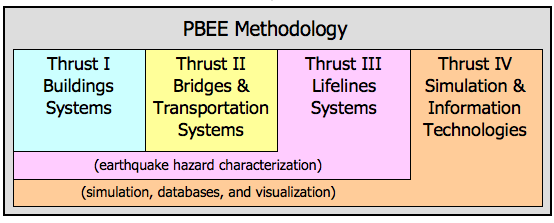Research Program Overview
The PEER research program funds and coordinates research in support of the PEER mission in performance-based earthquake engineering. The broad scope of the mission requires an equally broad research agenda. The program includes elements of fault rupture; transmission of seismic waves from the source to the site; local site response as affected by local geologic conditions; interaction among the soil, foundation, and structure components; analysis of system dynamic response; assessment of the performance of the structural and nonstructural systems; consequences in terms of casualties, capital costs, and post-earthquake functionality; and decision-making to respond to earthquake effects or to change the design parameters to effect improved performance.
To accomplish its research program, PEER involves researchers from the earth sciences, engineering, and social sciences communities, who work together to develop an integrated approach to the performance-based earthquake engineering problem.

The PEER research program aims to provide data, models, and software tools to support a formalized performance-based earthquake engineering methodology. Within the broad field of earthquake engineering, PEER’s research currently is focused on four thrusts, these being Building Systems, Bridge and Transportation Systems, Lifelines Systems, and Information Technologies in support of the methodology implementation. The for thrusts have the following components:

- - Thrust Area I – Building Systems
- The new Building Thrust Area combines researchers from four of the five previous thrust areas—Loss Modeling and Decision Making, Geotechnical Performance, Assessment and Design Methodology, and Structural and Nonstructural Performance. This is similar to the structure of the testbeds, which also combined researchers across thrust areas. The advances made in each thrust area and in the testbeds shaped the decision to create the Building Thrust Area.
- - Thrust Area II – Bridges and Transportation Systems
- The Bridges and Transportation Systems research program is directed toward further developing the performance-based earthquake engineering (PBEE) methodology developed by PEER and demonstrating its utility through application to difficult bridge design problems that integrate structural and geotechnical considerations.
- - Thrust Area III – Lifelines Component & System Hazards
- The Lifelines Components and Systems research program is directed toward increasing the reliability and safety of geographically distributed lifelines systems including transportation and utility lifelines. The performance of a lifeline system is governed by three considerations:
- the regional distribution of earthquake ground motion and ground failure,
- the performance of individual components to ground shaking and ground failure, and
- the interaction among the multiple components of the lifeline system and the impact of damage on flow through the lifeline system.
- - Thrust Area IV – Simulation & Information Technologies
- The goal of Thrust Area IV is to develop new simulation models and methods for performance-based earthquake engineering assessment and design methodologies, develop modern simulation software tools taking advantage of information technology advances, deliver the software tools to the community, and educate students in simulation methods and information technology applications in earthquake engineering.
For additional details, see the PEER Annual Report (PDF file - 7.6 MB).

